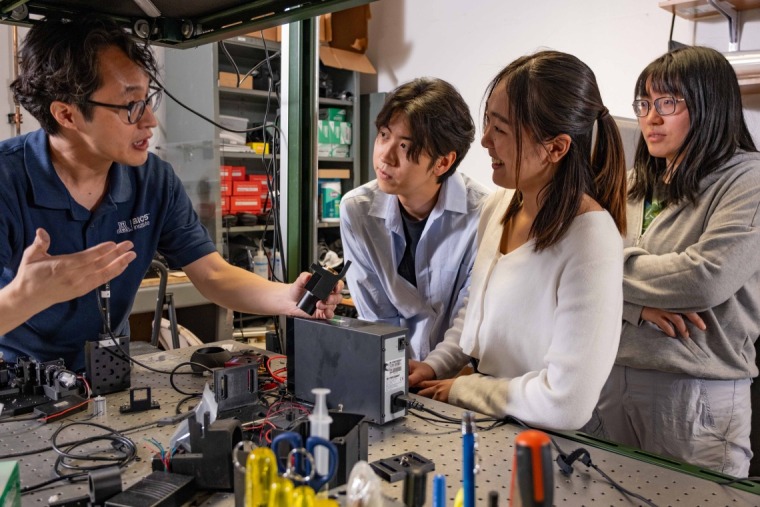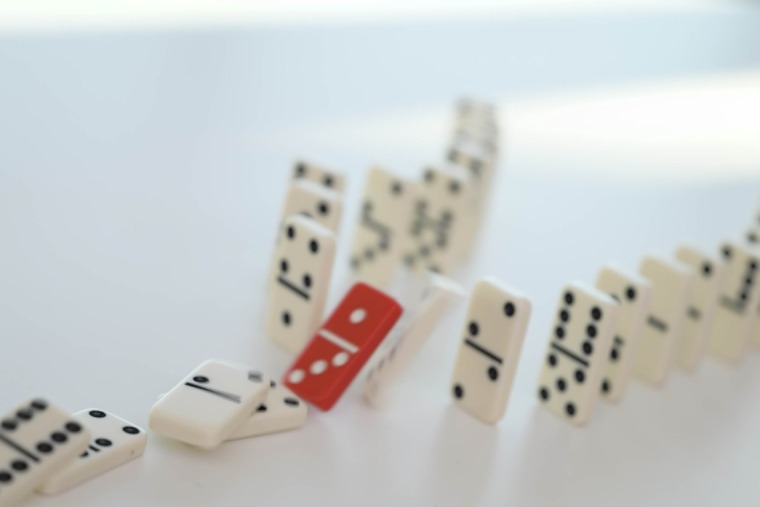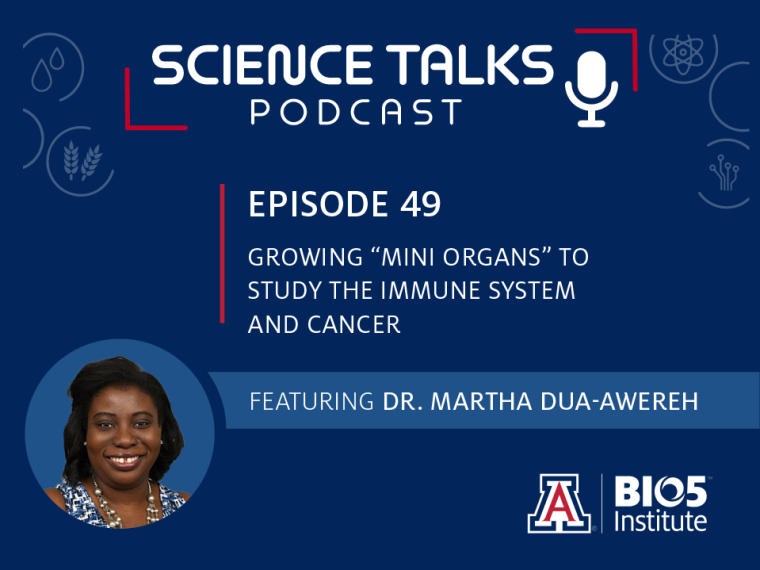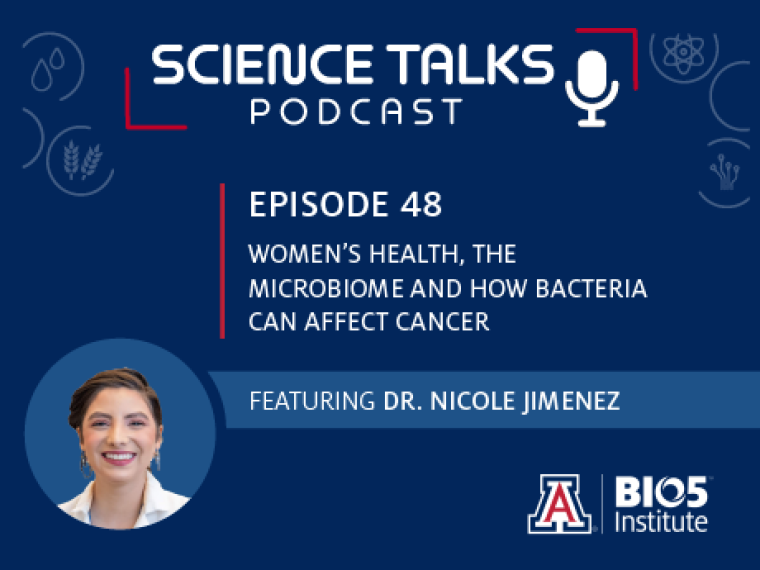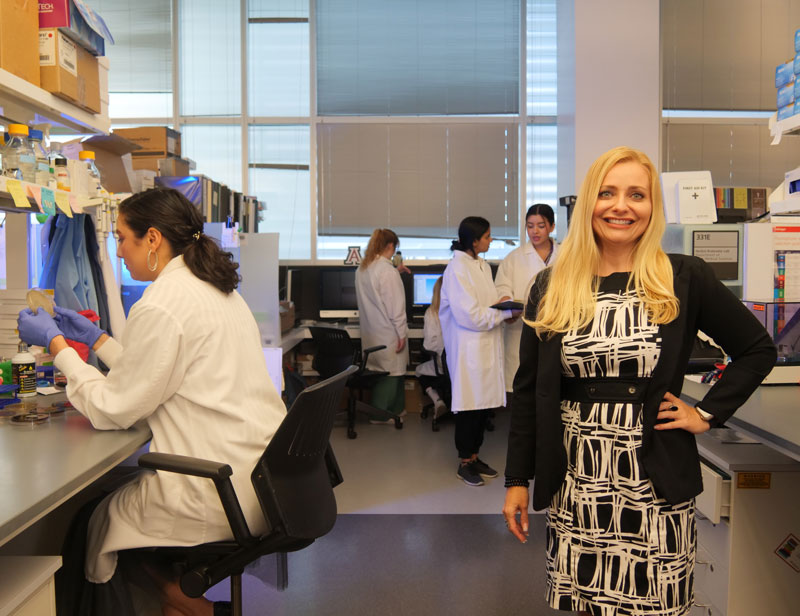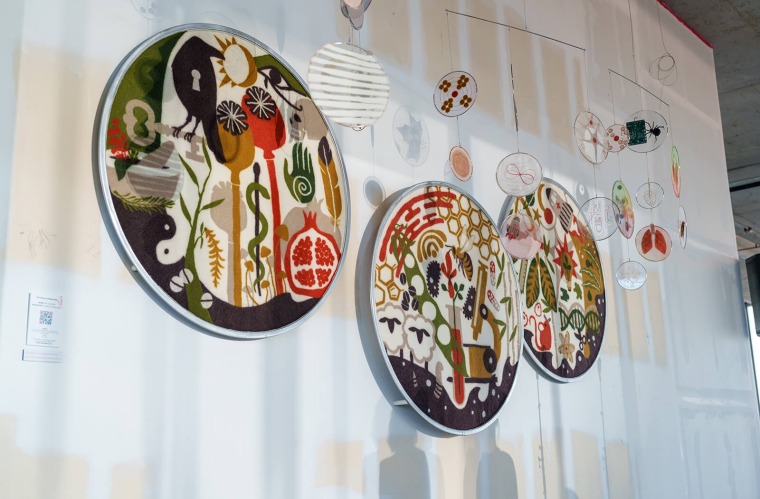Cancer is an incredibly complex disease. To better understand how it interacts with the human body, researchers in the lab grow organoids, miniature three-dimensional tissue cultures derived from stem cells. Amy Randall-Barber from the BIO5 Institute was joined on Science Talks by Dr. Martha Dua-Awereh who uses organoids to study colorectal and pancreatic cancer with the Alfred Bothwell lab in the Department of Immunobiology at the University of Arizona College of Medicine — Tucson. Dr. Dua-Awereh earned her PhD from the Department of Systems Biology and Physiology at the University of Cincinnati School of Medicine and was a 2023 BIO5 Postdoctoral fellow. She is the first in her family to live in Arizona, and additionally has several other firsts that are discussed in the interview.
As of the publication of this podcast and interview, Dr. Martha Dua-Awereh has taken a position as researcher at Avery Therapeutics, Inc. and Dr. Alfred Bothwell has left the University of Arizona.
This interview has been edited for length and clarity.
ARB: To get started, I have a couple of icebreaker questions. Question number one: What is your favorite place you’ve ever been to?
My favorite place is Brooklyn, New York. And I will tell you why, soon.
ARB: What is something that you've always wanted to do, but you've not done yet?
I've always wanted to go to Ghana and Paris. My family is originally from Ghana, but I was born and raised in Brooklyn, New York. My mom wanted to go to Ghana with me, but we haven't had the time or money. Same for Paris, I want to go to Paris because it’s beautiful. Hopefully in the next couple of years, I'll be able to go and see both.
ARB: Absolutely!
You are the first in your family to live in Arizona – what brought you here?
I was born and raised in Brooklyn, New York, went to college in Philadelphia, then back to Brooklyn to finish another degree, and then decided to go to Cincinnati for graduate school.
While I was there, my mentor, Dr. Yana Zavros, got offered a position at the University of Arizona. Generally, if you want to take a student with you to another institution you can, but you don't necessarily have to. But she decided to take me with her, and discussed with the program coordinator before she approached me and said, ‘Hi, I'm going to go’ and I said, ‘Sure!’
So, I came here and virtually completed my degree. Afterwards, I decided to stay when I got offered a job. Dr. Zavros, as well as other mentors, such as Dr. Juanita Merchant, reached out to people and Dr. Bothwell contacted me before I even finished my degree.
ARB: We’re glad you stayed!
Can you tell us about your series of 'firsts’? I should disclose that I saw a video online while doing research for this podcast that you did for postdoctoral affairs here at the University of Arizona, where you mentioned these.
I guess the number one ‘first’ was being born in the US. I'm the first in my family, since our family is from Ghana. There's an aspect that's embedded of being Ghanian in everything that we do, then being American, I add an extra layer to that. Through my eyes as a Ghanaian American, I see my family get exposed to many things, good or bad.
Another first is leaving New York. My family is from Ghana and London, but the ones that come to New York tend to stay in New York and not branch out to the rest of the country. Since I've been to different places, I've established this culture, this pattern of traveling. My nieces and nephews have also done the same thing. In fact, my sister and my niece are coming to visit me in Arizona. They've never been but now they have a reason to. My nephew, when he was looking at colleges, looked outside of New York. That was something that impacted my family. Even my mother who never wanted to leave New York, is now in Arizona with me.
In terms of education and pursuing a tertiary degree, I was first in my family to do that, but I'm not the last. My nieces and nephews have done it. It's become an option that once you finish high school, we should look at college and then look beyond that.
My ‘firsts’ have established a legacy for my family, a way for them to use me as a troubleshooter, the fixer. I can give them information about things they should do, what can be improved on, and what they can add to their lives in ways they didn't expect.
For me it's been an adventure. And for them, it's been a learning experience.
ARB: That's great that you're inspiring your family and sharing your experiences. It's been brave of you to be the first for everything.
I'm not someone who I would describe as adventurous or daring. But I am curious. I think my curiosity has led me to different paths in my life.
ARB: That's what they say about scientists; curiosity is the biggest element to becoming a scientist.
Let's talk about your research. You are in Dr. Bothwell's lab, can you tell us about the overall research goals and how it impacts human health?
Our lab is mainly an immunology and cancer research lab. We look at ways the immune system interacts with not just cancer, but also other types of diseases. We look at infections, for example Leishmania infection, a parasitic disease found in parts of the tropics, subtropics, and southern Europe.
We also look at how the immune system interacts with cancer, mainly whether cancer can manipulate it. The reason we look at these things is to see if we can identify targets to improve upon therapies regarding infection or cancer. We look at not just the ways the immune system recognizes cancer and destroys it, but ways that the cancer can manipulate the immune system to hide and to mask its function. For example, cancer can trick the immune system into thinking that it is also an immune cell.
ARB: I've heard about the immune system being used to fight cancer, but the way that you've just explained it was awesome, thank you. We need that research more than ever.
What is your current project in your fellowship and in the lab?
I mentioned immunology cancer research component, that's mainly my focus. I work with pancreatic and colorectal cancer. I'm looking to see whether there are factors that encourage these cancer cells to have more interactions with immune cells.
There's this process called trogocytosis, which usually happens between immune cells where they recognize each other, and they take parts of the cell and make it their own without killing or destroying the other cell. Cancer can have this interaction with the immune cells, too. It's very unusual, but it can happen, and there might be some cancers where it happens more often. We're trying to figure out what factors contribute to that, what makes trogocytosis happen in one type of cancer, in one cell versus another.
We're seeing whether these same factors allow cancer cells the ability to expand and grow, depending on the part of the body. They're localized, just like every part of your body, every organ, there's a different environment, different cells. And cancer can sometimes be the same way. But there's an extra step that allows cancer to transcend this, and we're investigating what factors make that switch in the cancer cell from being localized to spreading, or metastasizing. So, I also look at metastasis and whether there might be correlation between this ability for the cancer cell to mask itself from the immune system.
ARB: Is that the work you are doing for the fellowship?
The fellowship is providing me opportunities to run tests. Because of so many different factors involved with cancer and the immune system, we want to look exactly at which genes might be expressed, overregulated, and affected. I'm also able to use the fellowship to travel, go to conferences, and talk more about my science. It can be difficult to do, especially for me, since my research is not the easiest to understand. It's still complicated for me, and I work on it every single day!
Being able to share is not only impactful to my field but also people in general, and the fellowship has allowed me to do that.
ARB: Have you done any trips yet this year?
Not yet, but I’ve planned two trips.
ARB: Where are you going?
The first trip is in Chicago and it’s for the American Association of Immunologists. I've never been and will hopefully be presenting my research. Then the second trip is for the American Physiological Society, which I am a member of. I've gone on different trips as a graduate student, but this is the first time I'll be going as a postdoc to talk about my research.
ARB: That’s great, I hope you meet collaborators or pick up some great ideas.
So, in a video that I saw of you, online that you did for the UArizona Postdoctoral Affairs Department here, you mentioned organoids. What is an organoid?
An organoid is kind of what it sounds like, it's a mini organ. That's a very simple way of breaking it down. In cell culture, people take cells and plate them on dishes, and it’s a 2D system where cells are interacting. Whereas with organoids, you can look at a 3D interaction. It’s almost as if you are looking at a smaller version of what you would expect in your organs.
Matrigel is one of the components we use to grow organoids, and it's supposed to be a matrix that mimics what you have in your body. So, you're not just getting the interactions of the cells, but how they interact with different factors, such as cell culture.
So, organoids are just little versions of your organs, and they can be made up of different cells that make up your organs.
ARB: Can you grow an organoid that is specific for the liver or pancreas?
Exactly, yes, I work with colorectal cancer, so I will work with pancreas or colon organoids. I think people have been able to isolate or generate organoids from almost every organ. If not all, very close.
ARB: How cool that scientists have been able to come so far with this research that helps humans and can hopefully cure cancer someday.
Right. And how do we generate organoids? Well, that process is interesting.
I've generated organoids from mouse organs and human organs. One way is through a tissue sample or biopsy, and another way is through stem cells. But what you need for the basic level of an organoid is a stem cell. Depending on what we add to the culture, the stem cell will mimic those same cells as your organ. We can break tissues down and grow organoids from it.
ARB: How do you get human tissue?
Great question. Here at the University of Arizona, there's a repository with a research core where patients who come in for procedures that require a biopsy can donate a sample. This repository will collect that tissue and preserve it. It's usually frozen tissue, sometimes it can be fresh, but we ask for samples of tissue to grow organoids. Along with the repository, there’s a research core that will take those same tissues, generate organoids and freeze them for when we need them.
It's hard to get human tissues, because of course, you can’t go to everyone and say, ‘Hey, can have a piece of your tissue?’ So, we appreciate these contributions. Particularly from my research where I'm working on studies that directly apply to human treatments, and ideally working with human cells is great.
With every sample, I am so appreciative, and it's made me look at science in a completely new and multifaceted way.
ARB: How can people find out about donating? Or is it truly happenstance?
There are a couple of ways. Sometimes you through a physician or scientist directly, especially if they are doing clinical trial or clinical study. They may collect those samples to be passed over to the laboratory.
Another way is through collaborations with Banner Hospital and University of Arizona. I think there's a pathway set up where people in the research core are notified by physicians about a patient who is coming in for a procedure, so they can ask the patient beforehand.
I think the best way is to work with the research core directly to make requests for different types of tissues from different populations. Because we also want to see whether there's difference between men and women, and I'm particularly interested in minority populations.
I guess it's not as well advertised as I would hope it would be, but I think there's more awareness of how important it is. We have limitations of tests or exploring theories working with humans. This allows us to see whether a particular drug or chemotherapy works without putting a person through unnecessary trauma or burden.
ARB: I think everybody can think of a person who has been affected by cancer.
Initially, I wasn't sure I wanted to go into cancer. But my brother was diagnosed with metastatic lung cancer a couple of years ago and passed away very suddenly. I think one of the issues that affects our family to this day is that he didn't want to tell us about it. And I think if he had known how much I was involved with cancer, maybe he would have felt more confident in talking to me, what therapies to explore, or how serious it is. In our family, there are members that weren't aware of how much it would affect his life and how quickly it would do so.
ARB: It really rocked a lot of people’s worlds because it went so quickly. I’m sorry.
Thank you. I have friends who are confused about their friends’ cancer and why they respond well to some therapies but not others.
My goal is to figure out what factors might cause those differences so people can have a better understanding of how cancer affects your life and what we can do about it.
ARB: My mom passed away from breast cancer about nine years ago. She had surgery and was cancer-free for four years. And they say there’s a five-year window, and in the fifth year, it came back as bone cancer and metastasized. We all wondered about the same things. Like, why did it come back? How come it couldn't stay away? Like, why didn't they detect it sooner? Just lots of questions and no answers.
You touched on this a bit earlier when you mentioned a mentor who brought you here to Arizona. Do you have any influential mentors in your life, whether it's career or personal?
There’s so many. The first person I always think about is my mom. She influences my personal and academic work, motivating and pushing me. My mom didn't have the chance to go to college, even though she wanted to. And she wanted to make sure that I had those opportunities.
Even now, to this day, if I work too hard, she says, ‘Hey, take a break.” She reminds me to take care of myself, which I usually forget to do.
And then, who I mentioned before, Dr. Zavros. She’s here at the University of Arizona still and it’s easy to pop in when she's available and say, ‘Hey, I have a question.’ And then there’s a senior scientist who works in the repository research core, Dr. Jayati Chakrabarti. I usually have questions about organoids both in terms of work and grants. And they remind me that my work is important and go and try different experiments.
I have mentors outside the University of Arizona, which I think is important. One is Dr. Arnaldo Diaz Vasquez, the associate dean at the University of Texas Southwestern. And I met him when I was at the University of Pennsylvania for a summer program. He coordinated that program, and maintained a relationship with me so I could ask all kinds of questions. Should I present this poster? Should I talk to this person?
And I’m continuing to get mentors. I work in Dr. Bothwell’s lab, and one of our next-door labs is Dr. Justin Wilson, and I can get the perspective of being a new faculty member from him.
ARB: I've noticed how willing faculty are to answer questions since we give a lot of tours. And the undergraduates will ask how they can work in a lab. And my honest answer is just email them and they will email you back!
Yes, I was there once. Asking as many people as you can for information really helps. And the University of Arizona excels at that.
ARB: Right! So, what’s next for you?
That's a great question. I’m hoping to finish my postdoc in the next couple of years. From there, I know I want to do cancer research. I'm not sure if I want to do it in academia right away, because there are things in government that I'm also interested in terms of policy.
For a short while, I did have medical education, and I really did love seeing patients. There's a lot of pre-clinical research questions about human health or human conditions. And usually, I'm the one to answer those questions, and I’ve realized how important that is when it comes to science. So, I might even go back and pursue medicine to tie it all together.
The next steps may be doing a bit more research or more education to do more research!
ARB: Wow! Thank you again for coming to Science Talks and sharing your story.
